Seagate's Momentus XT Reviewed, Finally a Good Hybrid HDD
by Anand Lal Shimpi on May 24, 2010 9:31 AM EST- Posted in
- Storage
- SSDs
- Seagate
- Momentus XT
- Hybrid Drive
- SSHDs
The Test - Real World First
Before we get to our usual benchmarks I put together a few hand timed tests to help convey the experience the Momentus XT offers. Seagate badly wants the world to think that the Momentus XT is SSD-like in its performance. In my opinion it performs more like a fast hard drive rather than an SSD, but regardless of what you want to call it the tests below are designed to help convey the user experience.
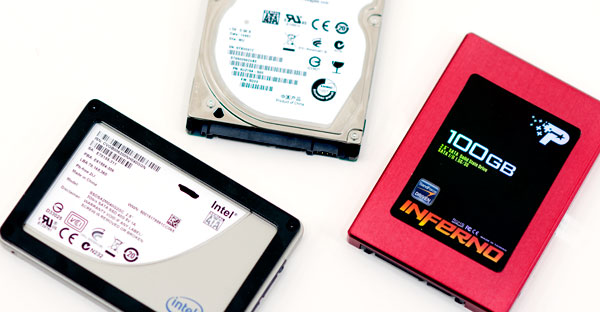
To aid in our comparison I've thrown in two SSDs: the Intel X25-V and the Patriot Inferno. The X25-V is a small, but affordable SSD while the Inferno is based on the SandForce SF-1200 controller making it one of the fastest and most expensive consumer SSDs we've tested. We've also got the new 600GB VelociRaptor and Seagate's own Momentus 5400.6, a fairly standard 5400RPM 2.5" drive for comparison. While a better comparison would have been a modern 7200RPM 2.5" drive, we didn't have one handy in time for this review. The 5400.6 should give you a general idea of how all 2.5" drives will perform though; 7200RPM drives will be faster but not by a huge margin.
These are mature results, measured on the third of three runs so the Momentus XT has more than enough time to learn (between each run I rebooted the machine).
| CPU | Intel Core i7 965 running at 3.2GHz (Turbo & EIST Disabled) |
| Motherboard: | Intel DX58SO (Intel X58) |
| Chipset: | Intel X58 + Marvell SATA 6Gbps PCIe |
| Chipset Drivers: | Intel 9.1.1.1015 + Intel IMSM 8.9 |
| Memory: | Qimonda DDR3-1333 4 x 1GB (7-7-7-20) |
| Video Card: | eVGA GeForce GTX 285 |
| Video Drivers: | NVIDIA ForceWare 190.38 64-bit |
| Desktop Resolution: | 1920 x 1200 |
| OS: | Windows 7 x64 |
Our first test is a timed boot. You are looking at the time from initial OS load (not POST) to getting a cursor at the Windows 7 desktop.
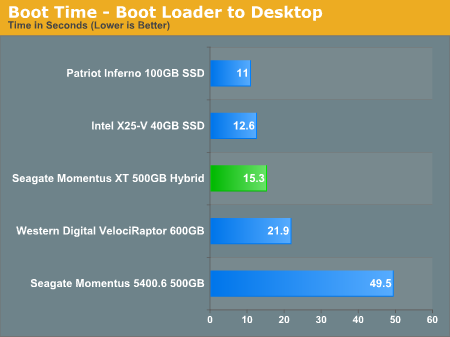
The Windows 7 boot process is a very read intensive task that's easy for the Momentus XT to learn. Seagate may be on to something here, the Momentus XT is much more like a SSD than a HDD in this test. Even the VelociRaptor is no match for it. The SSDs are still faster, but they don't offer nearly the same capacity as the hybrid drive. Compared to a standard 2.5" notebook drive the Momentus XT is a no brainer, it's in a league of its own.
Adobe's Photoshop CS4 is a great application launch test as it can take a fairly long time to load. Here we're just timing the period from clicking on the CS4 icon to ending up at the Photoshop workspace.
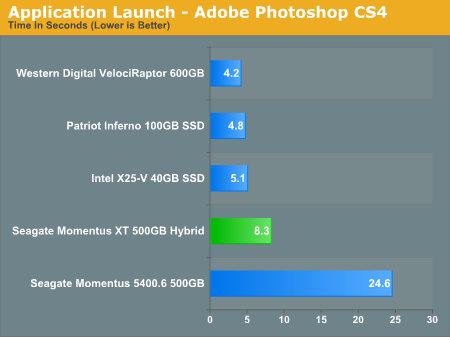
The new VelociRaptor is slightly, but consistently faster than both of the SSDs in this chart. It does still have a few tricks left up its sleeve. The Momentus XT is about half the speed of the SSDs and 10K RPM HDD here, but much faster than the 2.5" 5400RPM notebook hard drive. It's noticeably faster than your standard notebook HDD but it does feel slower than a SSD. That is an important distinction as throughout my experience with the drive it felt like a fast hard drive, rather than an SSD. Part of the reason there is because the NAND isn't used for writes, so you still get the high latency response time whenever there are any random writes happening in the background.
Our standard Photoshop CS4 performance test in our reviews is optimized for comparing CPUs and as such it's set to only record the previous action. With only one level of history, the benchmark is not nearly as disk intensive as Photoshop can get. For this test I ran our CS4 benchmark but left the application at its default setting of remembering the previous 20 actions. With more to keep track of, performance goes down while the reliance on a fast storage subsystem goes up.
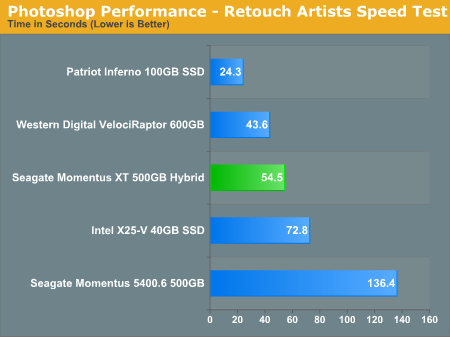
The X25-V is penalized by having a very low sequential write speed. The combination of heavy reads and writes means that the Momentus XT behaves more like a normal hard drive and less like an SSD. The 4GB SLC read cache does help though, while the hybrid drive isn't faster than the VelociRaptor it's pretty close for being a 2.5" notebook drive. The 100GB SandForce drive is much faster than anything else here, but it does offer 1/5 the space at 2.5x the cost of the Momentus XT.
For the next test I wanted to see how well the Momentus XT would cache a single large file. I timed how long it took to load a 70MB Excel sheet:
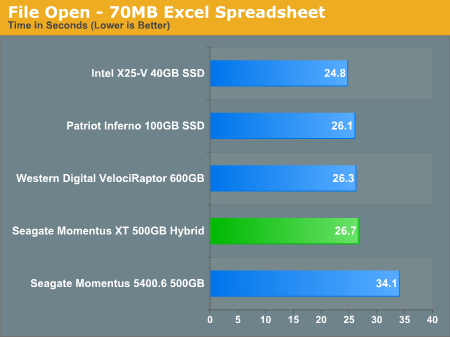
The results are a lot closer than you'd expect. Despite having a 4GB SLC NAND read cache, the Excel load time isn't any better than the VelociRaptor (although it is faster than the 2.5" 5400RPM drive). The upper bound in performance is set by the SSDs so it looks like the Momentus XT's cache does as much as physically possible to improve performance, we're simply bound elsewhere.
My favorite test for showing the usefulness of an SSD is to load a bunch of applications immediately after booting to the desktop. On a system with a hard drive there are usually a lot of disk accesses right after you hit the desktop that will slow down any application launches. A well made SSD acts like nothing is going on in the background. But what about the Momentus XT?
To test it I threw Internet Explorer, Outlook 2007, Access 2007, Excel 2007, PowerPoint 2007, Word 2007 and Photoshop CS4 in the startup folder of my testbed. The times below measure how long it took to load all of those applications immediately after boot:
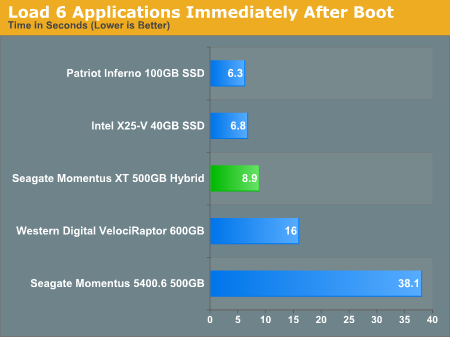
I'm impressed. While it's not quite as fast as an SSD, Seagate's Momentus XT is faster than any hard drive here. It's fast enough in this test where you might even consider using one in a desktop instead of a VelociRaptor. There is still the issue of random write performance (it is a 7200RPM 2.5" drive after all) but this is very good. It's because of this that Seagate believes the Momentus XT is delivering a SSD-like experience and in this test I'd have to agree.










120 Comments
View All Comments
pkoi - Monday, May 24, 2010 - link
I have a 30gig SSD and haven't yet figured how to take advantage of it. OS and all program is above 100gig + 90% of It I don't read often.This is such a lost of NAND beyond 40 gig, I bet people with 80gig ssd don't read heavily on more than 30% of it's capacity.
About Time someone sort out for us, what file need to be on SSD and what doesn't.
x0rg - Monday, May 24, 2010 - link
I would add $50 to buy X25-M 80GB and $50 more for external 250GB WD Passport, and that would make me happier :) I'm already using X25-M in my desktop for about a year and I'm not going down for any hybrid, SSD only as a system drive.Fox5 - Monday, May 24, 2010 - link
All this seems to be doing in the same thing as the almost universally panned readyboost. Microsoft even had a spec for this called readydrive, and Intel had robson.If they enabled Readyboost on a PCIE or SATA drive, you could likely get this same performance (or better) by adding a low capacity SSD to your system. What would happen if you dedicated a small SSD to a pagefile btw? Does Windows persistently store page file information between boots, thus using it to speed boot times?
pkoi - Monday, May 24, 2010 - link
I'd also like an answer to this, What software is able to sort out the "to be cached files ?"mpx999 - Tuesday, May 25, 2010 - link
Not really. Seagate decides what to cache based on disk block level. This is much more universal approach than file-statistics-based readyboost, as it allows to cache most frequently used blocks from large files, like virtual machine virtual disks or those giant *.dat files of games. Readyboost is good to speed up access to lots of small files, like *.dll *.ini or small exe, but is no good for extracting most used blocks of large files.x0rg - Monday, May 24, 2010 - link
Could you add another regular Seagate Momentus 500GB hard drive 7200 rpm (not 5400)?That would be interesting to see if there is real difference between the regular HDD and the hybrid one.
skwareballz - Monday, May 24, 2010 - link
You said that power would be equal or lesser to most HDDs, and I was wondering if that was do to the power used x time taken to complete w/e? Most charts showed the power consumption higher than the 5400.6 which could be a pretty average notebook HDD, but the time to boot up and what-not were much lower for the H-HHD. Just trying to figure out if watts/sec average would be lower and allow more battery life?Thanks for the good review, too.
7Enigma - Monday, May 24, 2010 - link
Anand,I've been very pleased with your wait-and-see approach to most new technologies from the SSD front. So I was a bit shocked to see a glowing recommendation without the disclaimer to wait and see what happens in the next couple of months. This is potentially a great notebook drive (honestly for desktops a real SSD + mechanical HD is vastly superior but yes more expensive), but until we see some firmware updates and/or issues with the drive I think it should remain a recommendation with a major warning.
Thank you for the article; glad you're back!
Endoas - Monday, May 24, 2010 - link
Any idea how hot these things get compared to a traditional HDD or SSD? I don't see any tests regarding this issue.iwodo - Monday, May 24, 2010 - link
Currently 4GB is being limited simply because of Software problem ( 64Bit OS Required ) rather then Hardware, We can already make single stick 4GB DDR3 cheaply, only the market is not there yet. When 64Bit reaches tipping point, ( 1 - 2 years time ), 4GB System would be minimum with 8GB or even 16GB system. With So much RAM we could cache those Random Read Write Directly to RAM. Why would would need a Hybrid HDD?The Built in NAND Flash doesn't make any sense to me.